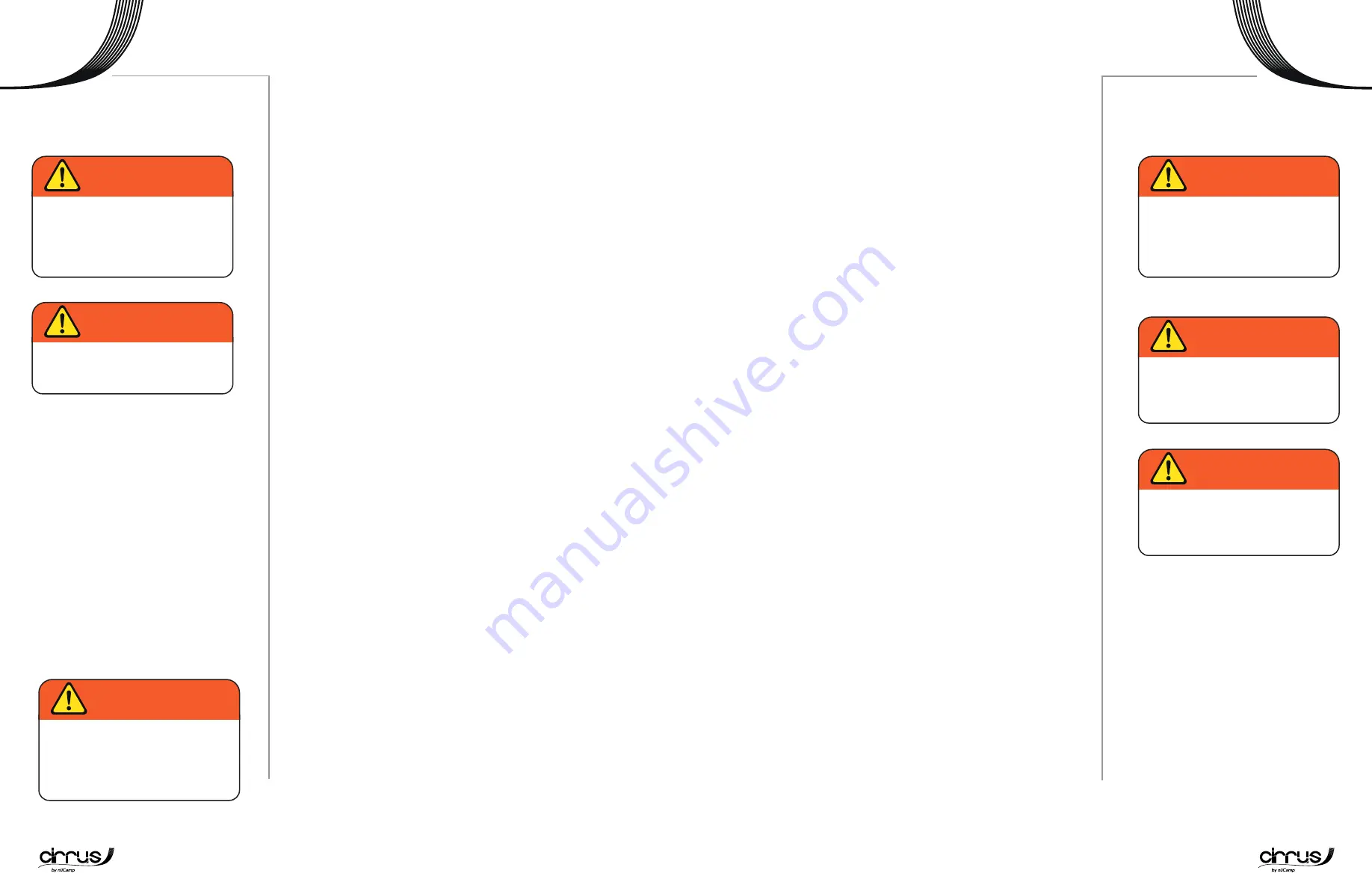
Truck Campers • nucamprv.com
12
nucamprv.com • Truck Campers
13
Practice the following:
• Teach all occupants how to operate the EXIT window before
an emergency.
• In the Family Safety Plan decide in what order occupants will exit
the camper in an emergency.
• When setting up the camper for use, check that the EXIT window
is not blocked by obstacles such as branches or trees. Have solid,
level ground below and outside the window with a clear path
of escape.
• Have a blanket or heavy coat ready to serve as a cushion on the
window frame.
• The last person to exit must be prepared to assist those going first.
• Open and close the Emergency Exit Window on each trip to keep
the window from potentially sticking to the seal.
• Lock the Emergency Exit window while traveling or hauling
the camper.
SMOKE ALARM
Your camper is equipped with a smoke alarm. The alarm will only sound
when smoke reaches it. Read the user manual for the smoke alarm to find
all needed information regarding its operation.
Important Information
:
• The alarm is powered by a standard 9-volt battery. When the
battery is connected a red LED light will blink.
• When the alarm is activated by smoke, it will beep repeatedly, and
the LED light will flash rapidly.
•
Never disable the alarm for nuisance sake or false alarms.
This
could be fatal if you forget to turn it back on. Ventilate the cabin
with fresh air instead.
• Test your smoke alarm with these steps:
1. Press and hold the test button until alarm sounds.
2. Alarm will beep about four times.
3. If there is no sound replace the alarm or supply a new battery.
• The smoke alarm is designed to give you advance notice to the
presence of smoke which may lead to open flames.
• If the alarm sounds, evacuate the camper immediately and call 911.
• Replace the alarm when it reaches its expiration date.
Carbon Monoxide Poisoning Symptoms:
Dizziness
Vomiting
Drowsiness
Shortness of breath
Weakness
Confusion
Runny nose
Blurred vision
Sore or watery eyes
Unconsciousness
Dull headache
Brain damage
Nausea
Death
Test smoke alarm for proper function
after camper has been taken out of
storage, once per week and before each
trip. If the smoke alarm does not test
properly, replace it immediately.
WARNING
Never use open flame to test the smoke
alarm. This can set the smoke alarm and
your camper on fire.
WARNING
In most cases of CO poisoning, individuals becomes aware they are not
feeling well but become so disoriented they aren’t able to save themselves
by getting to fresh air or calling for help. This is especially dangerous for
people who are sleeping or intoxicated. Pets, babies and small children are
usually the first affected by CO poisoning.
It is very important to have exhaust fans running and an air inlet such
as a window open when operating fuel burning appliances.
CO & LP GAS ALARM
Your camper is equipped with a CO/Propane Leak alarm near the floor
that will sound when Carbon Monoxide reaches dangerous levels or if a
propane leak occurs.
If alarm signal sounds:
1. Move to fresh air immediately. Evacuate all persons from the
camper, leaving doors and windows open and execute your Safety
Plan. Do not silence the alarm. If possible, shut off gas supply at the
source and turn off all gas appliances.
2. Call Emergency Services. Do not re-enter the camper until
Emergency Service responders have arrived, the camper has been
aired out and your alarm returns to normal condition.
3. If the alarm re-activates after 24 hours, it may be evidence of a
propane leak or appliance malfunction. Repeat steps 1 and 2 and
then have a qualified technician investigate. If equipment needs
serviced, do so immediately. If a technician is not available, contact
the nearest fire department for assistance.
How to test alarm for proper operation: (Unit must be powered on for
at least three minutes before testing)
1. Press the “TEST” button until the alarm sounds.
2. All LEDs will light up and alarm will sound twice.
3. The LED flashes red and returns to normal operation displaying a
flashing green LED every 8 seconds.
4. If alarm does not sound or light up, you may need to have a service
technician examine and/or repair it.
Important Information:
• The alarm is powered by the 12V DC system. Disconnect the battery
when not using the camper to keep the battery from being drained.
• The alarm will need to be replaced after 7 years.
• Read the user manual for the alarm found in your Owner’s Packet for
complete safety instructions and troubleshooting and incorporate
useful practices listed therein into your Safety Plan.
• The alarm sensor may detect other vapors such as gasoline,
acetone, alcohol, butane and other fumes that can be found in
perfumes, alcoholic beverages, adhesives, kerosene, cleaning
agents and aerosol cans.
• Read all safety related messages in the propane gas section of this
manual. [See pages 30-32]
If the CO alarm sounds GET OUT of the
camper immediately to fresh air. Open
doors and windows and turn on fans to
air out the camper. Determine the cause
of the CO before reoccupying the camper.
WARNING
Test carbon monoxide alarm for proper
function after camper has been taken out
of storage, once per week and before each
trip. If the CO alarm malfunctions or does
not test properly, replace it immediately.
WARNING
Do not use open flame such as a cigarette
lighter to test the CO/Propane gas alarm.
Sensors may damage and alarm may
catch fire.
WARNING
If a vehicle or generator is running
near your camper, CO emissions can
potentially filter through the air system
into your camper.
WARNING





























